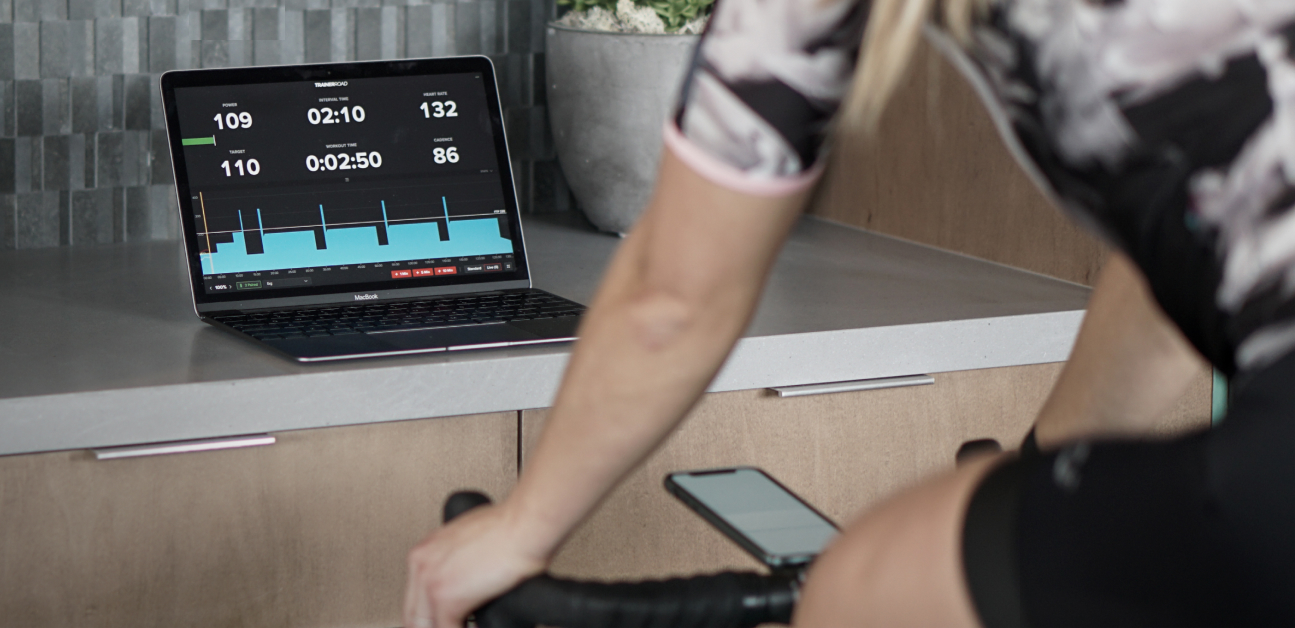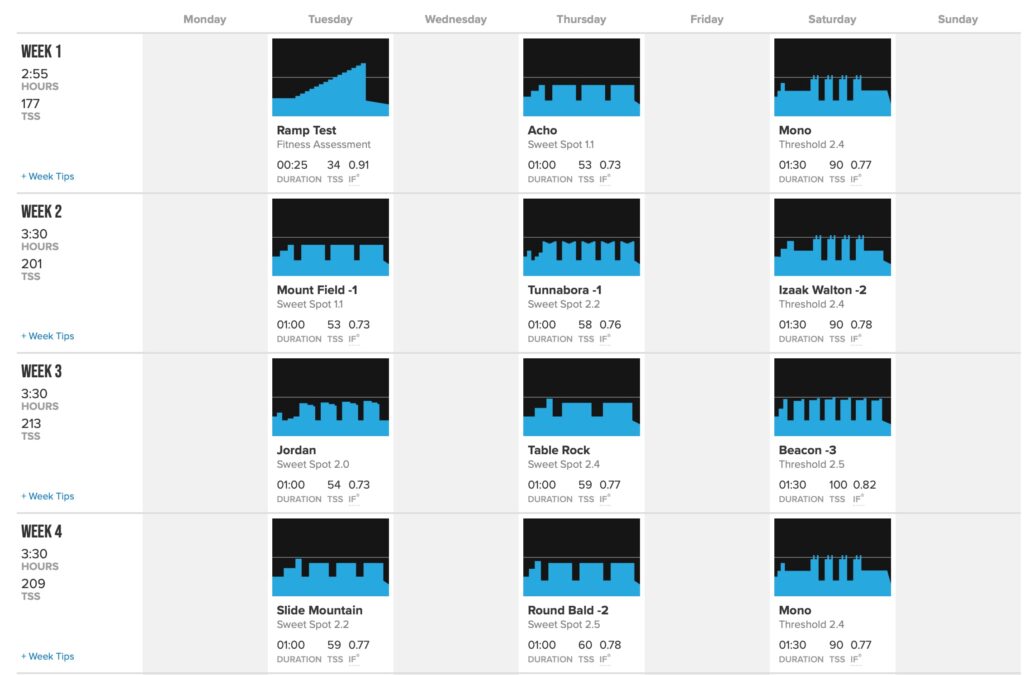Cycling Training: Beginner’s Guide to Getting Faster

Whatever your goals are and however you ride, you can become a faster cyclist, with the right training. From setting goals to choosing a training plan, our beginner’s guide to cycling training covers everything you need to get started.
Table of Contents
Getting Started with Cycling Training
Getting started with cycling training can be daunting when you first begin. No matter your current level of fitness or experience though, you can start getting faster with cycling training. In other words, you don’t need any prior training to train.
Before you get started with a cycling training plan, it’s a good idea to pinpoint your goals. Is there an event like a Gran Fondo you want to prepare for? Or maybe you want to get faster for group rides or just increase your fitness? Whatever your reason for getting faster, a challenging yet attainable goal helps provide direction and motivation.
Adaptive Training
Get the right workout, every time with training that adapts to you.
Check Out TrainerRoadOnce you have your goals in mind, it’s time to choose a training plan. The easiest way to pick one is by using Plan Builder. Whether you want to race or not, Plan Builder is for any cyclist that wants to get faster. It uses your experience, your schedule, and your goals, to create a custom plan based on your specific needs.
What is a Cycling Training Plan for a Beginner?
In general, cycling training for beginners isn’t all that different from training for athletes with lots of experience. The best training begins with a plan and uses specific power-based workouts that provide just the right stimulus at the right time while giving you enough time for rest and recovery. This is called structured cycling training.
Structured cycling training is a process by which you train specific energy systems while progressively stressing your body. Over time, you’ll gain performance-boosting adaptations, which increase your power output and muscular endurance. It all begins with a plan that accounts for your available training time, goals, experience, and current capabilities—so every workout is tailored to your particular needs.
In contrast to structured training, the alternative is to ride a lot. Yes, you can get fitter by just riding your bike. But that takes a considerable time investment, and sooner rather than later, there will not be enough stimulus, and you’ll hit a plateau. Structured training provides the right workouts at the right time, so you can break through and reach your goals.
Training with Power
TrainerRoad training plans and workouts are power-based. Power-based training with a power meter, or a smart trainer, provides two major advantages. First, with power, you can objectively assess your abilities with a power-based fitness assessment. A power-based fitness assessment provides you with your functional threshold power, which is used to tailor your workouts to your current fitness.
FTP or functional threshold power is an approximation of the highest sustainable power you can hold for an hour. FTP is used to calibrate each workout to your current fitness level. That way, your workouts remain productive and you get the most out of every workout.
Second, power meters allow you to accurately measure the amount of work you’re doing in real-time. This work is organized into specific power zones, which are defined as a percentage of your FTP. Riding in each zone stresses your body in different ways and stimulates various physiological adaptations.
If you don’t have a power meter or a smart trainer you can still reap the benefits of power-based training. TrainerRoad offers an easy way to train with power, even if you don’t have a power meter with VirtualPower.
Intervals
Every TrainerRoad workout is designed around power zones following a specific structure called intervals. Interval workouts are workouts with alternating high-power bursts and periods of rest. Typically the high-power segment is targeted to a particular power zone. There are intervals designed to raise your threshold, VO2 Max, and sprint power. A typical interval workout will feature several intervals called a set. At the end of each set, there will be a period of extended recovery before the next one begins.
Depending on the targeted energy system, the intervals may be shorter or longer, but all are scaled to your fitness level—your FTP. Usually, the most intense intervals are shorter and lengthen as you lower the intensity. For example, a VO2 Max interval might be one-minute, whereas a Sweet Spot could be twenty minutes long.
Training Phases
But what types of workouts should you do and when should you do them? Your training plan should be organized into distinct training phases that build your fitness progressively. A typical training phase will begin by growing your base aerobic fitness, before layering on more specific work and bringing your fitness to a well-timed peak. This is the Base, Build, and Speciality cycle.
Base
The Base Phase of training is all about strengthening your aerobic energy system. This phase lasts between six and twelve weeks and starts at the beginning of your training season. This phase creates the foundation for future training phases by increasing the amount of work your muscles can do with oxygen and without contribution from the anaerobic energy system.
Build
The second phase of training is the Build Phase. During this phase, each workout takes on a more goal-specific form. Depending on your goals, you’ll begin to focus on sustained power, short bursts, or a mix of the two. Over these eight weeks, you’ll continue to maintain the aerobic fitness you’ve established in the Base Phase.
Specialty
Finally, the Speciality Phase sharpens your established fitness into its most goal-specific form, while reducing the overall training load to keep you fresh. Workouts in this phase are intense but come with a reduction in training volume. This taper will ensure that you are ready to experience your best performance for whatever goals you have.
How Much Should You Train?
TrainerRoad training plans come in three volumes: low volume, mid-volume, and high volume.
While the hourly commitment can vary, on average, the low-volume plans have three structured workouts per week, the mid-volume plans have five, and the high-volume plans have six. Whenever you start a new training plan, you’ll need to choose a volume for your plan.
When choosing a volume, we typically advise that you select the one that you can consistently complete. For beginners, the low-volume plan is the best volume to use. With four days of rest, this plan gives you time to recover, mentally recharge, and get a feel for interval training. It also gives you the opportunity to add other activities like group or trail rides—all without overwhelming your body.
Example Beginner Cycling Training Plan
For a beginner cycling training plan, we recommend using Plan Builder. It will create an ideal plan based on your goals, schedule, and experience. Here’s an example of the first few weeks of Sweet Spot Base.

This training plan will have you on the bike three times a week for up to 3.5 hours. You’ll start with a Ramp Test to assess your FTP and scale each workout to your abilities. During the week, you’ll complete hour-long Sweet Spot workouts, and on the weekend there will be slightly longer threshold workouts.
Going a step further, Adaptive Training will adapt individual workouts based on your performance. Depending on how you’re progressing, Adaptive Training will suggest a workout that best matches your current ability. To learn more, check out our blog post: Introducing Adaptive Training: The Right Workout, Every Time.
Training Indoors
Training indoors offers many benefits in comparison to riding outside. While riding outside is fun, it’s also dependent on the weather, traffic, and time. Indoor cycling training is incredibly convenient and efficient.
Advantages
Probably the most significant advantage to training indoors is that it’s convenient. With the right setup, you can easily hop on the bike for a workout regardless of the weather or time of day—allowing you to be more consistent. Additionally, training inside is incredibly efficient in both time and effectiveness. Because you’re constantly turning the pedals, you can get more work done in less time. Add because you don’t have to worry about the terrain or traffic you can hit your power targets precisely, and you’ll get faster in the most efficient manner possible.
Tips
Indoor training is a different experience than riding outside. For many beginners, one of the most significant differences to indoor cycling is constant pedaling. Typically, riding outdoors offers numerous small breaks in the form of coasting downhills or stopping at a traffic light. But the pedals are always turning on the trainer. Don’t worry; the constant pedaling will quickly become a strength that transfers to performance outside.
You’ll also want to keep your training area comfortable and convenient. While outside, you’ve got the breeze to help evaporate sweat, indoors you’ll want to get a good fan that moves a high volume of air. You can set things up in advance, like your bike, bottles, and towels for ultra-convenient workouts.